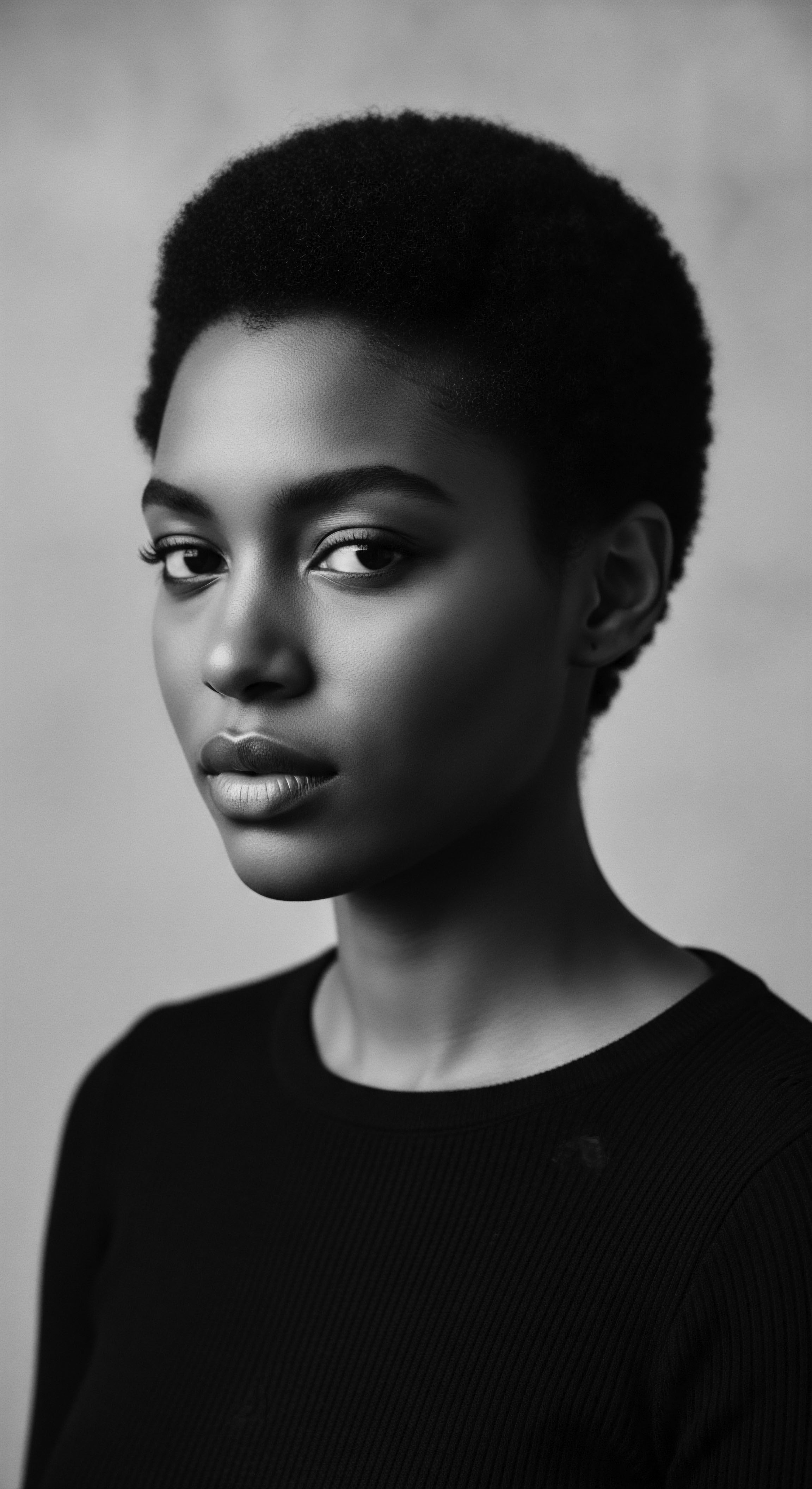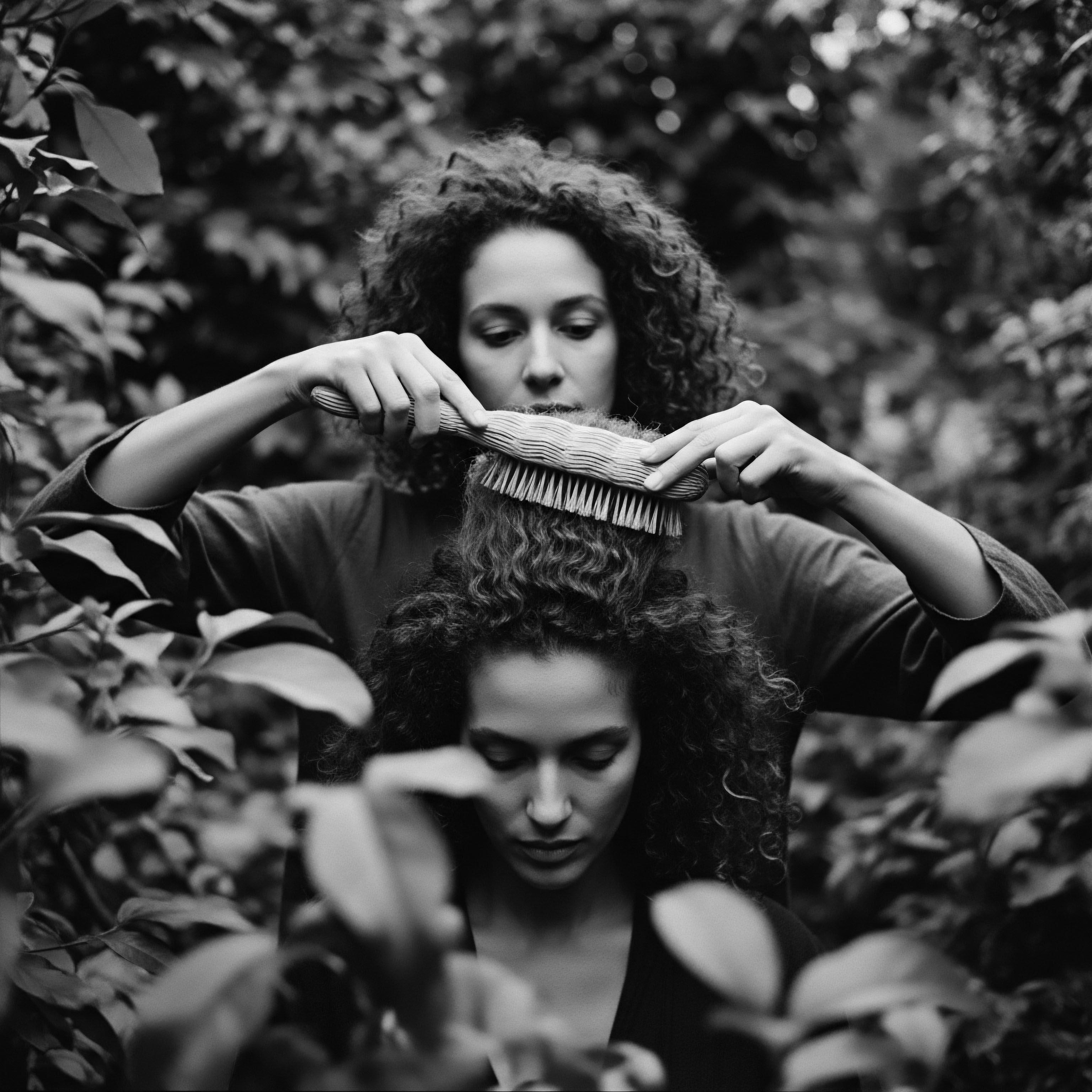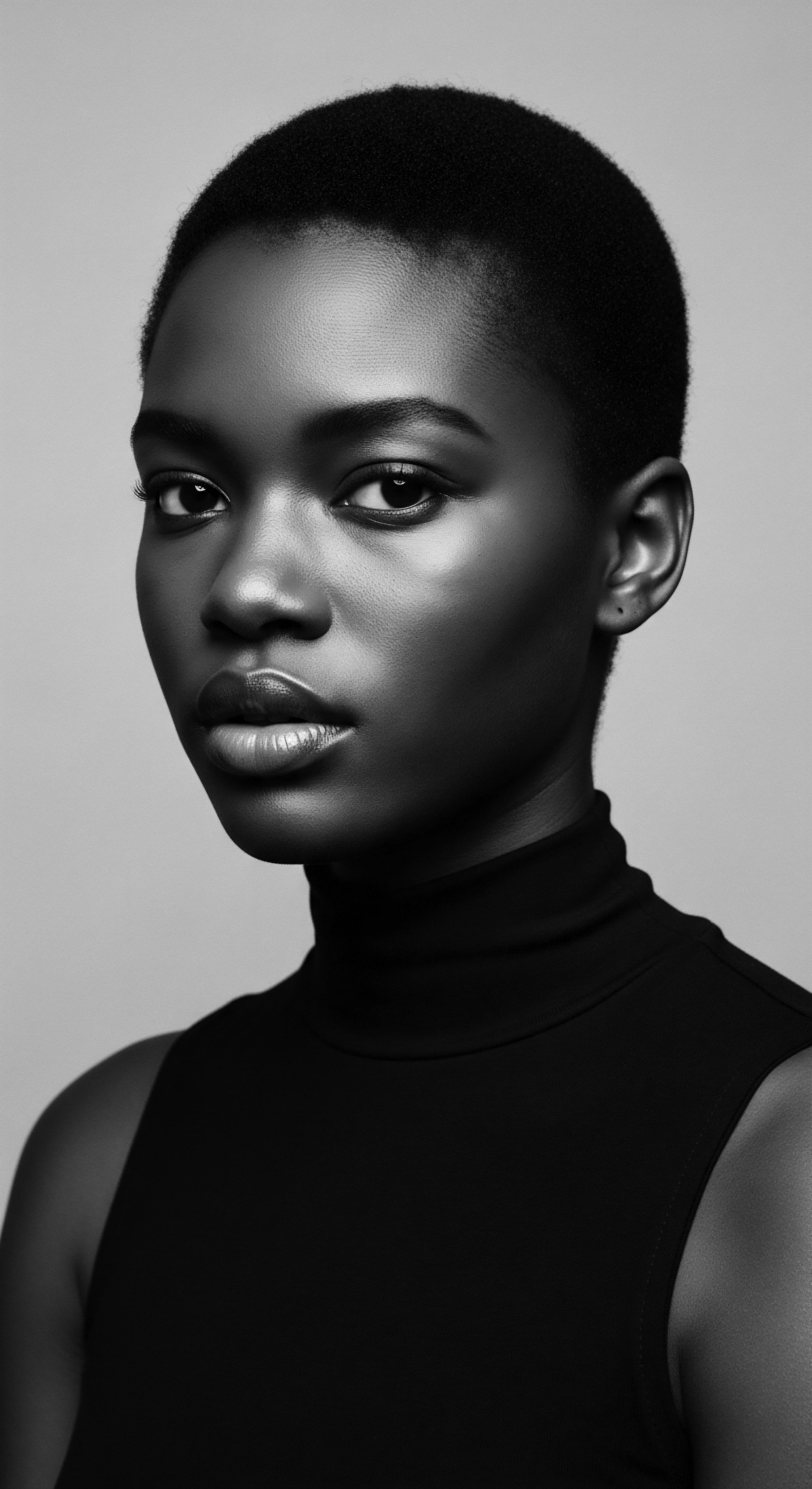
Roots
Consider for a moment the very helix of a single strand of textured hair, not as a mere biological filament, but as a living archive. Within its coils and curves, it holds ancestral memories, echoes of hands that tended it through millennia, under sun-drenched skies and whispering winds. This deep connection, often unspoken, speaks volumes about the communal significance ancient hair oiling rituals held for textured hair. It began with an innate understanding of what the hair required to thrive in varied climates.
The human touch, a balm itself, became intertwined with botanicals and rich animal fats, transforming a simple act of conditioning into something far more profound. This practice wasn’t simply about cosmetic appeal; it embodied a communal understanding of wellness, identity, and spirit, handed down through generations.

The Architecture of Ancestral Strands
Textured hair, with its unique structural properties, possesses a natural inclination towards dryness due to the winding path of its cuticle layers. This morphology, a gift of adaptation to diverse environments, meant that ancient communities intuitively sought ways to provide external moisture and protection. Our forebears, observant and wise, recognized the need for emollients long before modern science articulated lipid barriers or hydrophobic properties. They used what the earth provided ❉ nourishing oils from indigenous plants, animal fats, and mineral-rich clays.
These substances, carefully prepared and applied, shielded the hair from harsh elements, retained its vital moisture, and imparted a luminous vitality. The very act of this practical application became a language of care, whispered from elder to youth.
Ancient hair oiling rituals were communal acts that fortified not only strands but also the bonds of heritage.
The lexicon surrounding textured hair has always been rich, imbued with cultural meaning. Terms for various curl patterns, densities, and textures existed within oral traditions, guiding the selection of appropriate oils and methods. This shared vocabulary served to categorize and understand, certainly, yet it also celebrated the immense diversity of hair within a community, affirming each person’s place within the collective.
For instance, the understanding of how tightly coiled hair might benefit more from heavier, sealing oils, or how a looser curl could gain from lighter applications, was not taught in textbooks, but passed along in the intimate setting of communal grooming sessions. These moments of shared knowledge formed the bedrock of hair care traditions, defining both personal and collective beauty.

Early Forms of Hair Protection
Archaeological findings from various ancient civilizations provide glimpses into these early practices. In ancient Egypt, for example, elaborate wigs and natural hair were meticulously cared for, often with unguents made from castor and almond oil, designed to promote growth and enhance shine. These preparations were applied not only for aesthetic reasons but also for protective purposes, shielding the scalp from the desert sun and maintaining hair health in arid conditions.
This ritualized application extended beyond the individual; it was a societal norm, often performed within family units or by skilled practitioners who understood the spiritual weight of their craft. Such practices underscored a communal value placed on well-maintained hair as a symbol of status, cleanliness, and connection to the divine.
Further south, across the vast continent of Africa, a spectrum of oiling practices evolved, each tailored to specific regional plants and communal needs. The Himba people of Namibia, for instance, traditionally use a paste of ochre, butter, and herbs to coat their hair, creating distinctive reddish-brown dreadlocked styles. This practice, known as ‘otjize,’ protects the hair and skin from the sun and insects.
It is a daily ritual often performed collectively, symbolizing their profound connection to the earth and their ancestors. The longevity of these methods demonstrates a deep ecological intelligence, where ingredients from the immediate environment were understood for their beneficial properties and integrated into daily communal life.
- Shea Butter ❉ A staple in West African communities, renowned for its moisturizing and healing properties, extracted from the nuts of the shea tree.
- Argan Oil ❉ Often called ‘liquid gold’ in Morocco, valued for its nourishing and rejuvenating effects on hair and skin.
- Coconut Oil ❉ A common element in tropical regions, historically used for its moisturizing and protective qualities, especially in ancient Ayurvedic practices.

Ritual
The transition from practical application to profound ritual is where ancient hair oiling truly distinguished its communal significance for textured hair. These were not solitary acts performed in haste; they were often extended sessions, rich with conversation, laughter, and the gentle rhythm of hands at work. Picture generations gathered, often women, their fingers moving with practiced grace, massaging oils into scalps, detangling coils, and preparing hair for intricate styles. This shared labor fostered an intangible warmth, strengthening familial bonds and reinforcing the collective identity that pulsed through the heart of the community.

Communal Gatherings and Social Bonds
Communal hair grooming, particularly braiding sessions, served as central social activities in many African societies. These gatherings were more than just about styling hair; they were sacred spaces for knowledge transfer and social cohesion. Mothers taught daughters, aunts guided nieces, and friends supported one another through hours-long processes. Stories of ancestors, lessons on societal expectations, advice on navigating life’s challenges, and local gossip passed freely between generations.
The hands at work, coated in fragrant oils, became instruments of connection, building social solidarity even in trying circumstances. The rhythmic pulling and twisting, the application of rich butters, all deepened the sense of belonging.
Hair care sessions acted as informal schools, transmitting cultural values and historical narratives.
Such communal styling extended beyond daily maintenance to become a marker for significant events. Hair, as a visible aspect of one’s person, was meticulously prepared for ceremonies that celebrated life’s passages. These could involve elaborate oiling and styling before weddings, naming ceremonies for infants, or rites marking a young person’s entry into adulthood.
In these moments, the collective investment in preparing an individual’s hair underscored their importance to the group and the community’s shared hopes for their future. It was a tangible display of collective care and societal welcome.

Hair Oiling and Rites of Passage
The ceremonial nature of hair oiling was often tied directly to rites of passage, serving as a physical manifestation of transition. For example, among some West African cultures, the first hair oiling and styling of an infant could signify their formal welcome into the community, an act that literally anointed them with ancestral blessings. As individuals matured, specific styles requiring particular oiling techniques might indicate readiness for marriage, or a change in social standing within the community.
The Himba’s otjize, applied by family members, marks a woman’s journey through different life stages, from girlhood to marriage and motherhood. These rituals provided a visible timetable of an individual’s life within the community, understood by all.
Conversely, periods of mourning or spiritual introspection also saw specific hair care rituals, sometimes involving the cutting or subduing of hair, followed by special oiling to signify a return to balance or a new phase of healing. The careful tending of hair during these delicate times was a communal expression of empathy and support, a quiet acknowledgement of shared grief or renewed hope. This shows that hair oiling was not exclusively associated with celebration, but with the entire spectrum of human experience within the communal context.
| Community or Period Ancient Egypt |
| Hair Ritual Example Application of castor and almond oils to wigs and natural hair. |
| Communal Significance Symbolized status and cleanliness, often performed by specialists, reflecting societal value. |
| Community or Period Himba People (Namibia) |
| Hair Ritual Example Daily application of 'otjize' (ochre, butter, herb paste). |
| Communal Significance Marks life stages and communal identity, performed within family units, linking to earth and ancestors. |
| Community or Period Pre-Colonial West Africa |
| Hair Ritual Example Braiding and oiling sessions. |
| Communal Significance Served as social gatherings for storytelling, knowledge transfer, and strengthening familial and community bonds. |
| Community or Period These practices demonstrate how hair care was deeply integrated into the social and spiritual fabric of ancient communities. |

Relay
The ancestral echoes of hair oiling rituals, with their profound communal roots, did not vanish with the turning of eras. They were carried forward, a living legacy, particularly by those who faced the most arduous trials. The journey of these practices, often through forced displacement and cultural erasure, highlights an extraordinary resilience.
It speaks to the enduring human need for identity, connection, and self-affirmation, where hair care became a quiet yet potent act of defiance and cultural preservation. This continuation, a relay across generations and geographies, illuminates the true depth of communal significance.

The Perseverance of Practice Through Adversity
The transatlantic slave trade, a period of unimaginable brutality, attempted to strip enslaved Africans of their identity, language, and cultural practices. One of the first dehumanizing acts often involved forcibly shaving heads, a deliberate attempt to sever spiritual and communal ties. Yet, even in the crucible of enslavement, hair practices, including rudimentary oiling and intricate styling, persisted as a powerful form of resistance.
Enslaved individuals, separated from their kin and traditional tools, improvised with what was available—cooking oils, animal fats—to maintain connections to their heritage and to each other. These acts, often performed in secret or within small, trusted groups, were vital for maintaining morale and rebuilding a sense of family and cultural continuity.
Hair, and its careful maintenance with oils, served as a clandestine language, conveying messages of tribal origin, marital status, or even escape routes through hidden braid patterns. This silent communication underscored a profound communal reliance, where shared knowledge of hair care became a tool for survival and collective memory. The communal gathering to dress hair continued, albeit under duress, becoming a sanctuary where ancestral wisdom was whispered, stories shared, and a sense of dignity preserved against overwhelming odds. This demonstrates a deep human capacity for cultural persistence.

Connecting Ancestral Wisdom to Modern Understanding
The inherent properties of textured hair, which benefits immensely from moisture retention, found a practical ally in ancient oils. Modern scientific understanding now explains what ancestral wisdom always knew ❉ oils act as occlusives, sealing moisture into the hair shaft, reducing hygral fatigue, and protecting against environmental stressors. Ricinoleic acid in castor oil, for example, known to ancient Egyptians and traditional African societies for its perceived growth-promoting properties, today garners attention for its anti-inflammatory and antimicrobial qualities, contributing to scalp health. This modern validation of historical practices reinforces the authoritative nature of ancestral knowledge.
A study published in the International Journal of Dermatology by Ife J. Rodney and colleagues (Rodney et al. 2023, p. 1) emphasizes that “The Africans’ intricate hair styling process took hours to days to create and included washing, combing, oiling, braiding or twisting, and decorating the hair with cloth, beads, or shells.
This hair care ritual was viewed as a social opportunity to bond with family and friends, and this tradition still holds true today.”. This research highlights the enduring communal aspect of hair care, stretching from pre-colonial Africa into contemporary practices, confirming that oiling was an integral part of this social bonding. It underscores that the efficacy was not merely physical; it was deeply interwoven with psychological and communal well-being.
- Scalp Nourishment ❉ Many ancient oils, such as coconut and olive oil, provided essential fatty acids and antioxidants, directly contributing to scalp health and a healthy environment for hair growth.
- Moisture Retention ❉ Oils served as sealants, preventing the rapid loss of moisture from textured hair, which is prone to dryness due to its unique structure.
- Hair Fortification ❉ Regular oiling, often combined with gentle manipulation, helped to strengthen the hair shaft, reducing breakage and aiding in length retention.

How Did Hair Practices Become a Form of Cultural Heritage?
Hair, its styling, and the communal acts of care associated with it, solidified into a profound form of cultural heritage. It became a living, breathing artifact, transmitting values, aesthetics, and social structures across time. The knowledge of which oils to use, how to blend them, and the communal context for their application became invaluable assets, safeguarded and passed down even when other cultural expressions were suppressed.
The communal significance of oiling rituals, therefore, was not just about the moment of care itself, but about the perpetuation of identity through shared practice. It transformed from a simple grooming step into a symbol of collective survival and a celebration of an unbroken lineage.
The Chebe ritual of the Basara Arab women in Chad stands as a remarkable testament to this. For centuries, these women have used a powdered mixture containing Chebe, herbs, and oils, applied to their hair to help retain moisture and prevent breakage, enabling them to grow their hair to extraordinary lengths. This practice is a communal experience, with older women guiding younger ones, sharing stories and laughter, transforming it into a joyful, bonding experience. It is a tangible link to ancestral principles, demonstrating how hair care, sustained communally, preserves a unique cultural identity against the challenges of a harsh climate and changing world.

Reflection
The journey through ancient hair oiling rituals for textured hair reveals far more than historical grooming habits. It uncovers a profound meditation on interconnectedness, echoing the very ethos of Roothea’s ‘Soul of a Strand’—that each curl, each coil, holds a universe of meaning. These rituals, born of necessity and shaped by communal wisdom, stood as pillars of heritage, anchoring individuals to their lineage, their community, and the very spirit of their ancestors.
In the mindful application of ancestral oils, often under the patient hands of family members, a deeper nourishment took root. It was here, within these shared spaces, that the invisible threads of collective identity were strengthened. The laughter, the quiet conversations, the intergenerational teaching, all contributed to a sacred intimacy that transcended the physical act of care. The hair, once oiled and styled, became a vibrant canvas, broadcasting stories of status, spirituality, and belonging to the wider world.
Today, as we reconnect with these heritage practices, we participate in a continuous relay, honoring the ingenuity and resilience of those who came before us. To understand the communal significance of ancient hair oiling is to recognize textured hair as a living archive, not just of biology, but of profound cultural legacy. It reminds us that authentic care extends beyond product to embrace purpose, identity, and the enduring wisdom of our collective past. Our strands remain unbound, reaching towards a future that celebrates this rich, inherited splendor.

References
- Chimbiri, K.N. (2022). The Story of Afro Hair ❉ 5000 Years of History, Fashion and Styles. Scholastic.
- Ibhaze, O. L. (2022). Crowning Glory ❉ A History of African Hair Tradition. Melanin Djali Project.
- Rodney, I. J. et al. (2023). What Every Dermatologist Must Know About the History of Black Hair. Dermatology Times, 44(11), 1-4.
- Tharps, L. & Byrd, A. (2001). Hair Story ❉ Untangling the Roots of Black Hair in America. St. Martin’s Griffin.
- Byrd, A. L. & Tharps, L. D. (2014). Hair Story ❉ Untangling the Roots of Black Hair in America (Updated Edition). St. Martin’s Griffin.
